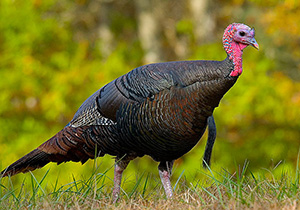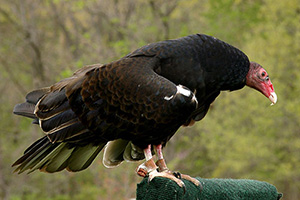You Sure We're in the Right Line? – Turkeys in NC Counties
You Sure We're in the Right Line? – Turkeys in NC Counties
By Site Ecology Team (SET), Wildlife and Industry Together (WAIT), Bill Willis, Bill Steinmetz, John McLamb
November 3, 2014

“I can’t wait to gobble down some of those scrumptious seeds, grasses, acorns, nuts, berries, and insects”. Yum! Yum!
This scenario plays out all across North Carolina in the fall. Turkeys have dispersed into all 100 North Carolina counties and across 49 states. The only exception is Alaska, where they refuse to go “cold turkey”. The birds were most numerous in North Carolina during colonial times but declined significantly due to habitat modification and unregulated hunting into the 1960’s. The early American Indians found multiple uses for this feathered friend: from food, feathers for head dresses and arrows, to using the leg spur as a tool. Restoration efforts were undertaken in the 1950’s and the bird population increased from mere thousands, 75-fold from 1970 to 2009. This out-come was accomplished by live trapping and relocating native birds. Releasing pen-raised birds into the wild is illegal due to the potential of introducing diseases into the native population.
All Dressed Out in Their Finest

Wild turkeys are very secretive and it’s exceptional to see one during daylight hours. Years ago they could be seen near the wood-line along Environmental Parkway at mid-day. This stretch provided a good mix of hardwoods and grasses to meet their habitat needs.
Several sightings have occurred in the past year at the intersection of Hopson Road/NC 55 and TW Alexander/NC 55. The EPA campus bird list includes turkeys as visitors to our campus. Although infrequently seen, they are here.
This character is a bird of a slightly different “feather”. Yes, it shares the “Turkey” name, but not much else. It’s a high flier whereas the wild turkey can barely get off the ground. Unlike the Turkey diet mentioned above, this guy is an opportunist and eats carrion (not to be confused with a similar sounding term “carry-on”). He’s a scavenger and finds his next meal mainly by smelling it, although his sight is remarkably good. It’s extremely rare for him to take a living animal, marinated suits him, and “good will come to he who waits.”
The turkey vultures migrate and have been documented to swarm. Shelby, NC in February 2013 had over 150 birds stop over for a respite. Can you just image how nervous that would make the neighbors? “How You Feeling? “Everything OK?” “You smell something?”
Who you looking at? Do I look like a turkey to you??

For those of you who know a real “Turkey”, it will come as no surprise to learn that they mature in one year and live only a few years in the wild. Some birds have taken human names like Tom*, Jake* or Jennie* which can become confusing at times.
The hen nests on the ground in dense cover in April, laying one egg a day for 5-15 days. After about a month’s incubation, the eggs hatch. Not unlike goose chicks, young turkeys must be prepared to leave the nest and forage within 12 to 24 hours. At night, turkeys will often fly into the woods to roost on tree branches. This action provides safety from predators like foxes, wolves, and coyotes. This month, keep your head down and your eyes open and you may get your chance to see a turkey au naturel.
*Toms are gobblers (males); Jake and Jennie refer to young males and females respectively.
Resources



